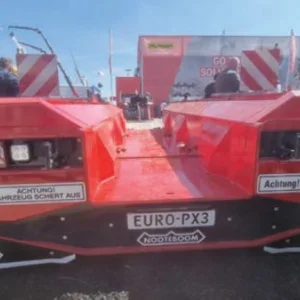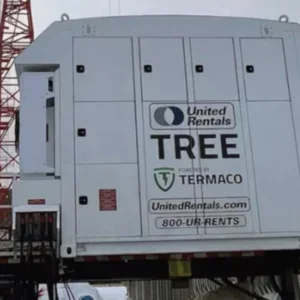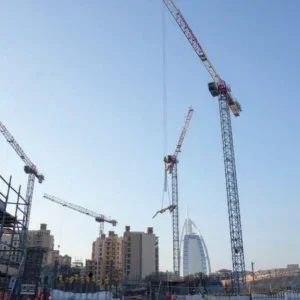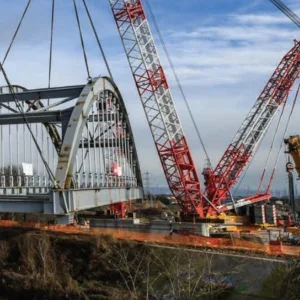Can there be anyone who has not seen the television footage of the two hijacked airliners being flown into the twin towers of the New York City World Trade Center on the 11 September, and the subsequent collapse of the buildings? These structures had stood at a height of 1,368ft (417m) and had defined the Manhattan skyline. With an unimaginable fire burning inside at 800°C, fed by the 80,000 litres of aviation kerosene that each 767 was carrying, steelwork weakened and both 110-storey towers collapsed to the ground. Many escaped between impact and collapse, but more than 5,500 people were killed.
In the hours and days that followed the terrorist attacks on the USA there were many deeds of remarkable courage and endeavour, not least by the firefighters who went into the burning buildings to save lives.
On Friday 28 September I visited the site, which had become known as Ground Zero. .I had thought that the hours spent watching television news footage would have prepared me for what to expect. I was wrong. There are some sites in the world, like the Taj Mahal and the Grand Canyon, that no photograph has ever truly captured. Ground Zero was like that, except in negative. It was powerful stuff.
The pile of twisted steel and rubble, the remaining representation of what were the tallest buildings of the world’s most dynamic city, was eerie. At Ground Zero that day I felt that I was witnessing some kind of battle between good and evil, where evil had been given too much head start. The sight of the fire fighters and the construction workers setting about their horrific task with single-minded commitment was inspiring, but it didn’t change the fact that there were thousands dead under that horrendous pile of rubble.
I cannot even imagine the feelings, the emotional torment, of those who experienced it first hand, or those who have spent weeks since that day working on site in shifts of 12 hours or more.
Jimmy Lomma arrived at Ground Zero at 9pm on 11 September. Lomma, owner of JF Lomma trucking company and New York Crane & Equipment, brought with him a 450 ton Krupp all-terrain crane and a 200 ton Demag. Rubber tyred machines were easier to mobilise swiftly. The next day he brought in more cranes. The city fire department and the Federal Emergency Management Agency (FEMA) were calling the shots. ‘They told us what to lift,’ Lomma says. For the first two weeks it was a search and rescue mission, carefully lifting away hunks of iron to give access to whatever survivors may be underneath. Union ironworkers, suspended in manbaskets or just climbing on the deathly pile, would drill holes in exposed steelwork and cut it into liftable segments. The cranes would pull the segments away and load them onto waiting trucks. Exactly what remains of the victims these guys found is too gruesome to report.
In the early days after the attack there was, inevitably, an element of chaos. This should not be read as any kind of criticism of the emergency services or the construction workers supporting them, however. Five factors were at work. Firstly, this was the scene of a crime, not a regular construction site. Secondly, the sheer scale of devastation made it hard to know quite where best to make a start. Thirdly, the emergency planning centre, set up after a bomb went off at the World Trade Center eight years ago, was on the eighth floor of one of the no-longer-standing towers. Fourthly, there was uncertainty about the integrity of surrounding structures, both above and below ground. And fifthly, such was the tremendous outpouring of goodwill that there were far more people making themselves available than could be managed, and more machines made available than could actually get to the site.
Two weeks later there was a much greater sense of routine – organised chaos, perhaps. Access had been strictly controlled and machines were, for the most part, working in a coordinated fashion. Getting trucks and machinery in and out was still a logistical game of Twister but it is apparent that all around were people who had a job to do and knew how to do it. Rubble was being removed at a rate estimated at 10,000 tons a day, and the road running north-south along the west side of the World Trade Center – Joe DiMaggio Highway – was accessible once again. For Lomma, this gave a staging area for his cranes to work from.
Among the FEMA specialists on site early on was Frank Bardonaro Jr, a volunteer who is the crane and rigging expert for the Ohio Task Force, FEMA Division. He is also the general manager of the Midwest operations of Maxim Crane Works. It took Bardonaro and the Ohio team until the following afternoon to reach the site since air traffic was halted. By that time, he says, the New Jersey and Massachusetts teams were already there. The Ohio team was designated an area of the site to search. For Bardanaro an early issue was finding a place to set up a 450 ton Demag.
The proximity of 500 volunteers searching through the rubble, and 200 ironworkers trying to hook things up made the site more dangerous than it already was, Bardonaro says. His prime role was trying to instill some coordination, stressing the need to synchronise the searching part of the operation with the lifting part. ‘The two had different goals,’ he says. ‘The crane and rigging people’s goal was to lift steel out of the way. The rescue workers’ goal was to get to the people. The two goals were pretty much in conflict. It was total chaos for the first three days, dangerously so. It was very frustrating because there were so many volunteers that were trying to help but they were basically in the way. It took until the third day before they realised that they had too many volunteers on site.’ After that, security was stepped up and access to the site was tightly controlled.
Bardonaro has nothing but the highest praise for all those involved in the crane operations. ‘We had some problems with excavators swinging around in confined spaces but we never had a problem with the cranes. We were able to coordinate their swing paths. It was a very impressive operation from a crane standpoint.’ Bardonaro says that, in the beginning, it was Jimmy Lomma who was calling all the shots as far as cranes were concerned. ‘Lomma was the lead person at the outset. He was the point man.’ Jimmy Lomma lives only ten minutes away from the World Trade Center site, just the other side of the Holland Tunnel, which when I visit he can still get through thanks only to his special pass, granted only to the emergency workers. ‘Jimmy lives for that city,’ I have been told on several occasions. He had a camper van on site, enabling him to grab the occasional couple of hours sleep. It was nearly two weeks before he got to go home and get some proper rest. It is not that he wanted to stay, he says, giving the impression that he couldn’t wait to get away from the sheer hell of the place, but the fire department had asked him to stay. They needed his advice regarding the machinery.
How has he coped, emotionally? ‘When you are busy, you don’t let it get to you,’ he says.
After a few days, when a greater degree of organisation was established, the 16 acre (6.5ha) World Trade Center site was divided into quadrants, with each being worked by one of four main contractors. Amec has the northwest sector, Bovis the southwest, Tully the southeast, and Turner the northeast. Working to these are one of three lifting and rigging contractors. Lomma is working to both Bovis and Amec, along the whole western side; Bay Crane is working to Turner in the northeast quadrant; and AmQuip is working to Tully in the southeast quadrant. Frank Bardonaro left the site after five days. ‘By then, the local contractors had taken over the equipment side of things,’ he said.
The city has budgeted $250m for each of the four contractors.
Lomma and Bay are the main players in the New York City crane rental scene, each taking about half the market. Competition is not exactly friendly, though each seems to recognise the excellence of the other’s operation. Amquip, based in Pennsylvania, has a depot in Carteret, New Jersey and its cranes visit the city only occasionally.
While at other times there may be professional rivalries, these were all put aside at Ground Zero. Says Bardonaro: ‘It didn’t matter what companies people were from, or what state. It was like an All-Star game instead of a Super Bowl. Everyone joined together and forgot about their team colours.’ Eight days after the attack Kenny Bernardo of Bay Crane was evidently a stressed man. ‘Safety is the main concern,’ he says. ‘There’s a lot of pressure.’ We agreed to talk later once he could afford the time. Unable to see him on site, I called him on 1 October.
‘It’s been tough for the men,’ he says. ‘It’s tough for everyone. It’s a tough place to work. It’s a tough thing, it really is.’ Clearly he has been affected by the events of 11 September. ‘I’m a native New Yorker, I live in Manhattan,’ he says. ‘The reality of it lingers every day. It just goes on and on.’ For Bay Crane, it was Kenny’s brother, Ray Bernardo, who led the efforts on site. Crane operator Tom Lennon is also cited as one of the company’s heroes, though there are many others, from all three companies and the local unions. Operators have been working 12 hour shifts, night and day, seven days a week.
Such shifts are not a problem, says Joe Wesley, president and owner of AmQuip. ‘People are used to working those hours, especially people in the rental business who are involved in turnarounds.’ For AmQuip, which has had up to 30 men on site, the key name is Bill Pace. ‘If anybody in our organisation deserves the credit, it’s Bill,’ says Wesley, his boss. ‘Bill Pace didn’t go to sleep for three days. Everybody else was there but he was organising it. He was just bouncing around like a ping pong ball.’ Pace stayed on site, sleeping occasionally on a camp bed in makeshift quarters, and finally went home for the weekend on Friday 20 September, returning again to the site on Monday morning.
‘During those first nine days we only slept for a total of 17 hours,’ says Pace. ‘When we weren’t building the equipment, we were working with the engineers.’ It was not an easy place to work, he says. ‘It was actually quite challenging, because everyone was a little bit spooked by what had occurred. There would be panic runs. Some glass would fall from a nearby building and that would set everyone off into a panic run away from the site. For the first 24 hours or so, it was common practice – it happened every two hours or so.’ Pace was better prepared than most to cope. ‘He’s an old marine and Vietnam vet,’ says Wesley, himself a former marine who saw action in Korea. Does AmQuip make a point of recruiting from the military? ‘Not particularly,’ says Wesley, ‘but we have found that that sort of background fits with following through with things.’ There are many unsung heroes of the World Trade Center response action, who gave support to the police, the fire brigade and the construction workers. The Red Cross, Salvation Army and local people just wanting to help out manned sustenance stations around the clock, handing out food, hot and cold drinks, cigarettes, counselling, whatever was required.
For Bardonaro, though, it was the ironworkers that made the greatest impression. ‘Everyone knows how heroic the fire brigade was, but I can tell you that the ironworkers were absolutely unbelievable at knowing what to do without being told, and getting the steel hooked and burned and lifted away. It was a real privilege to work with the unions up in New York.’






